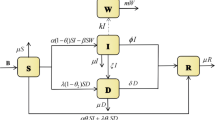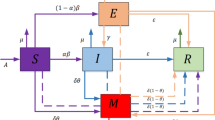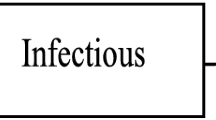Abstract
Social media platforms provide great convenience for public share and get access to various information, which bring challenges to both companies and company to manage negative impacts of public opinion. When an event happens, truth and rumors are intertwined in the process. To figure out how rumor influences the information diffusion process timely and identify points when necessary actions should be taken to control the impacts of rumors, an enhanced S–I–R (susceptible–infectious–recovered) dynamic model, involving rumors occurring sequentially in information diffusion process, is proposed. Based on the proposed model, we develop dynamic equations with the spreading probability and weight of the intervening acts. Then, we simulate how the process works theoretically where simulation in two different group of real-world datasets is conducted to demonstrate the validity of the proposed model. Besides, the present study illustrates that different spreading rates and weights of intervening acts could result in different diffusion situations, especially when the weight induces an increase in the peak point (ω2 = 0.5) and secondary climax(ω4 = 0.6). Finally, the present study provides suggestions practically for company in terms of managing rumor in online public opinion from different aspects. As our paper extend the research process of online public opinion to take rumor into consideration at two time periods, it not only enriches models of online public opinion diffusion process, but also shed lights on further studies concerning on online public opinion diffusion.





















Similar content being viewed by others
References
Qiu, L., Jia, W., Niu, W., et al. (2020). SIR-IM: SIR rumor spreading model with influence mechanism in social networks. Soft Computing, 25, 13949–13958.
Bin, Z., Yingying, H., & Peilin, S. (2021). Study on governance of information distortion based on competitive information dissemination model(in Chinese). Chinese Journal of Management Science, 29(2), 237–248.
Watts, D. J., & Dodds, P. S. (2007). Influentials, networks, and public opinion formation. Journal of Consumer Research. https://doi.org/10.1086/518527
Ma, L., Sun, B., & Kekre, S. (2015). The squeaky wheel gets the grease—An empirical analysis of customer voice and firm intervention on Twitter. Marketing Science, 34(5), 627–645.
Liu, X., Singh, P. V., & Srinivasan, K. (2016). A structured analysis of unstructured big data leveraging cloud computing. Marketing Science, 35(3), 363–388.
Li, L., Liu, Y., Zhou, Q., et al. (2020). Targeted influence maximization under a multifactor-based information propagation model. Information Sciences, 519, 124–140.
Zhong, N., Schweidel, D.A. (2020). Capturing Changes in Social Media Content: A Multiple Latent Changepoint Topic Model, Marketing Science.
Fossen, B. L., & Schweidel, D. A. (2019). Social TV, advertising and sales: Are social shows good for advertisers? Marketing Science, 38(2), 274–295.
Godes, D., & Silva, J. C. (2012). Sequential and temporal dynamics of online opinion. Marketing Science, 31(3), 448–473.
Gopalakrishnan, A., Bradlow, E. T., & Fader, P. S. (2017). A cross-cohort changepoint model for customer-base analysis. Marketing Science, 36(2), 195–213.
Zhu, F., & Zhang, X. M. (2010). Impact of online consumer reviews on sales: The moderating role of product and consumer characteristics. Journal of marketing, 74(2), 133–148.
Moe, W. W., & Schweidel, D. A. (2012). Online product opinions: Incidence, evaluation, and evolution. Marketing Science, 31(3), 372–386.
Moe, W. W., & Trusov, M. (2011). Measuring the value of social dynamics in online product ratings forums. Journal of Marketing Research, 48(3), 444–456.
Seo, J. H., & Kim, M. H. (2021). Finding influential communities in networks with multiple influence types. Information Sciences, 548, 254–274.
Sudbury, A. (1985). The proportion of the population never hearing a rumor. Applied Probability, 22(2), 443–446.
Wang, Y. Q., Yang, X. Y., Han, Y. L., & Wang, X. A. (2013). Rumor spreading model with trust mechanism in complex social networks. Communication Theory Physics, 59, 510.
Wang, W., Tang, M., Zhang, H. F., et al. (2014). Epidemic spreading on complex networks with general degree and weight distributions. Physics Review E, 90, 042–803.
Wang, T., et al. (2018). An information spreading model based on online social networks. Physica A: Statistical Mechanics and its Applications, 490, 488–496.
**a, L., Jiang, G., et al. (2015). Rumor spreading model considering hesitating mechanism in complex social networks. Physica A: Statistical Mechanics and its Applications, 390, 295–303.
Ding, X. J., Jiang, M., Tian, Y., et al. (2021). Rumor clarifying strategies considering restrain costs in online social networks(in Chinese). System Engineering-Theory and Practice, 41(5), 1119–1137.
Zan, Y. (2018). DSIR double-rumors spreading model in complex networks. Chaos Solitons Fraction, 110, 191–202.
Zhang, Y., & Zhu, J. (2018). Rumor spreading model in complex networks. Physica A: Statistical Mechanics and its Applications, 398, 43–55.
Juhász, P. L. (2021). Information propagation in stochastic networks. Physica A: Statistical Mechanics and its Applications, 577, 126070.
Dhifli, W., Karabadji, N. E. I., & Elati, M. (2020). Evolutionary mining of skyline clusters of attributed graph data. Information Sciences, 509, 501–514.
Huang, B., & Yu, G. (2015). Research and application of public opinion retrieval based on user behavior modeling. Neurocomputing, 167, 596–603.
Chen, W., Tseng, C. L., & Sunny Yang, S. J. (2020). Improving hand hygiene process compliance through process monitoring in healthcare. Manufacturing and Service Operations Management, 22(4), 669–682.
Baldassi, C., Cerreia-Vioglio, S., Maccheroni, F., Marinacci, M., & Pirazzini, M. (2020). A behavioral characterization of the drift diffusion model and its multialternative extension for choice under time pressure. Management Science, 66(11), 5075–5093.
Xu, J., Tang, W., Zhang, Y., et al. (2020). A dynamic dissemination model for recurring online public opinion. Nonlinear Dynamics. https://doi.org/10.1007/s11071-019-05353-3
Li, S., Liu, Z., & Li, Y. (2020). Temporal and spatial evolution of online public sentiment on emergencies. Information Processing and Management, 57(2), 102177.
Wang, H., Du, R., Shen, W., Qiu, L., & Fan, W. (2021). Product reviews: A benefit, a burden, or a trifle? How seller reputation affects the role of product reviews. MIS Quarterly (2022), 46(2), 1243–1272.
Yao, Y., Li, Y., **ong, **., Yue, Wu., Lin, H., & Shenggen, Ju. (2020). An interactive propagation model of multiple information in complex networks. Physica A: Statistical Mechanics and its Applications, 537, 122764.
Pastor-Satorras, R., Castellano, C., Van Mieghem, P., & Vespignani, A. (2015). Epidemic processes in complex networks. Reviews of Modern Physics, 87, 925–979.
Author information
Authors and Affiliations
Corresponding author
Rights and permissions
Springer Nature or its licensor holds exclusive rights to this article under a publishing agreement with the author(s) or other rightsholder(s); author self-archiving of the accepted manuscript version of this article is solely governed by the terms of such publishing agreement and applicable law.
About this article
Cite this article
Yan, Z., Zhou, X. & Du, R. An enhanced SIR dynamic model: the timing and changes in public opinion in the process of information diffusion. Electron Commer Res (2022). https://doi.org/10.1007/s10660-022-09608-x
Accepted:
Published:
DOI: https://doi.org/10.1007/s10660-022-09608-x




